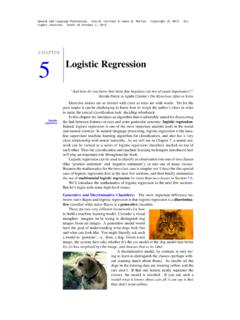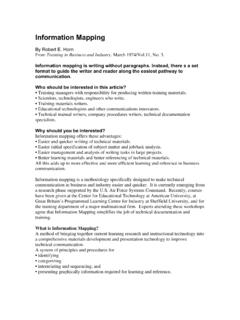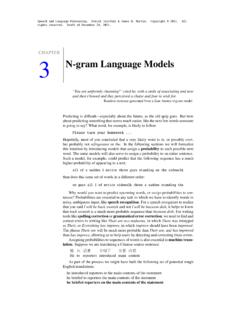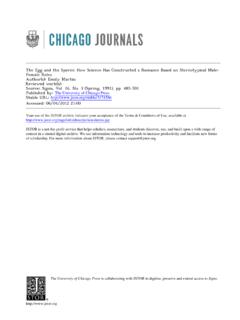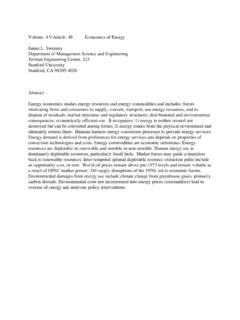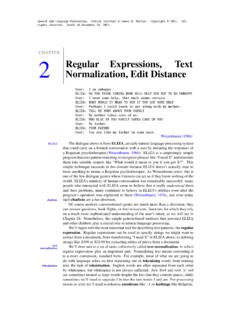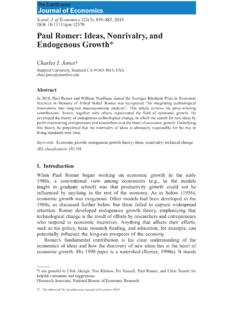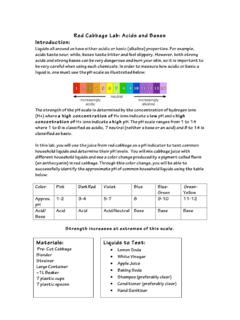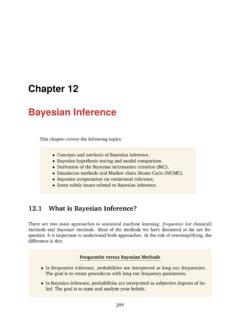Transcription of MEASUREMENT ERROR MODELS - Stanford University
1 MEASUREMENT ERROR MODELS . XIAOHONG CHEN and HAN HONG and DENIS NEKIPELOV1. Key words: Linear or nonlinear errors-in-variables MODELS , classical or nonclassical MEASUREMENT errors, attenuation bias, instrumental variables, double measurements, deconvolution, auxiliary sample JEL Classification: C1, C3. 1 Introduction Many economic data sets are contaminated by the mismeasured variables. The problem of MEASUREMENT errors is one of the most fundamental problems in empirical economics. The presence of MEASUREMENT errors causes biased and inconsistent parameter estimates and leads to erroneous conclusions to various degrees in economic analysis. Techniques for addressing MEASUREMENT ERROR problems can be classified along two dimensions. Different techniques are employed in linear errors-in-variables (EIV) MODELS and in nonlinear EIV.
2 MODELS . (In this article, a linear EIV model means it is linear in both the mismeasured variables and the parameters of interest; a nonlinear EIV model means it is nonlinear in the mismeasured variables.) Different methods are used to treat classical MEASUREMENT errors and nonclassical MEASUREMENT errors. (A MEASUREMENT ERROR is classical if it is in- dependent of the latent true variable; otherwise it is nonclassical .) Since various methods for linear EIV MODELS with classical MEASUREMENT errors are already known and are widely applied in empirical economics, in this survey we shall focus more on recent theoretical ad- vances on methods for identification and estimation of nonlinear EIV MODELS with classical or nonclassical MEASUREMENT errors. While MEASUREMENT ERROR problems can be as severe with time series data as with cross sectional data, in this survey we shall focus on cross 1.
3 Department of Economics, New York University and Department of Economics, Stanford University and Department of Economics, Duke University , USA. The authors acknowledge generous research supports from the NSF (Chen and Hong) and the Sloan Foundation (Hong). This is an article prepared for the Journal of Economic Literature. The authors thank the editor Roger Gordon for suggestions and Shouyue Yu for research assistance. The usual disclaimer applies. 1. sectional data and maintain the assumption that the data are independently and identically distributed. Due to the importance of the MEASUREMENT ERROR problems, there are huge amount of papers and several books on MEASUREMENT errors; hence it is impossible for us to review all the existing literature. Instead of attempting to cover as many papers as we could, we intend to survey relatively recent developments in econometrics and statistics literature on MEASUREMENT ERROR problems.
4 Reviews of earlier results on this subject can also be found in Fuller (1987), Carroll, Ruppert, and Stefanski (1995), Wansbeek and Meijer (2000), Bound, Brown, and Mathiowetz (2001), Hausman (Autumn, 2001) and Moffit and Ridder (to appear), to name only a few. In this survey we aim at introducing recent theoretical advances in MEASUREMENT errors to applied researchers. Instead of stating technical conditions rigorously, we mainly describe key ideas for identification and estimation, and refer readers to the original papers for technical details. Since most of the theoretical results on nonlinear EIV MODELS are very recent, there are not many empirical applications yet. We shall mention applications of these new methods whenever they are currently available. The rest of the survey is organized as follows.
5 Section 2 briefly mentions results for linear EIV MODELS with classical MEASUREMENT errors. Section 3 reviews results on nonlinear EIV MODELS with classical MEASUREMENT errors. Section 4 presents very recent results on nonlinear EIV MODELS with nonclassical MEASUREMENT errors, including misclassification in MODELS with discrete variables. Section 5. reviews results on bounds for parameters of interest when the EIV MODELS are only partially identified under weak assumptions. Section 6 briefly concludes. 2 Linear EIV Model With Classical Errors The classical MEASUREMENT ERROR assumption maintains that the MEASUREMENT errors in any of the variables in the data set are independent of all the true variables that are the objects of interest. The implication of this assumption in the linear least square regression 0.
6 Model yi = x i + i is well understood and is usually described in a standard econometrics textbook. Under this assumption, MEASUREMENT errors in the dependent variable yi = yi +vi do not lead to inconsistent estimate of the regression coefficients, as can be seen by rewriting 2. the model in yi : 0 0. yi = x i + i + vi = x i + i The only consequence of the presence of MEASUREMENT errors in the dependent variables is that they inflate the standard errors of these regression coefficient estimates. On the other hand, independent errors that are present in the observations of the regressors xi =. x i + i lead to attenuation bias in a simple univariate regression model and to inconsistent regression coefficient estimates in general. Attenuation bias: Consider a univariate classical linear regression model y = + x + , E(x ) = 0, (1).
7 Where x can only be observed with an additive, independent MEASUREMENT ERROR 0, 2 : . x = x + . (2). Then, the regression of y on x can be obtained by inserting (2) into (1): y = + x + u, u = . (3). Given a random sample of n observations (yi , xi ) on (y, x), the least squares estimator is given by: Pn j=1 (xj x ) yj = Pn . (4). j=1 (xj x j )2. Since x and u are correlated with each other Cov[x, u] = Cov[x + , ] = 2 6= 0, the least squares estimator should be inconsistent. Its probability limit is: Cov (x, u) 2 2. plim = + = 2 = , (5). V ar (x) + 2 2 + 2. where 2 = V ar (x ). Since 2 and 2 are both positive, is inconsistent for with an attenuation bias. This result can easily be extended to a multivariate linear regression model. In the multivariate case, one should notice that even if only the MEASUREMENT on a single regressor is ERROR -prone, the coefficients on all regressors are generally biased.
8 3. The importance of MEASUREMENT errors in analyzing the empirical implications of economic theories is highlighted in Milton Friedman's seminal book on the consumption theory of permanent income hypothesis (Friedman (1957)). In Friedman's model, both con- sumption and income are composed of a permanent component and a transitory component that can be due to MEASUREMENT errors or genuine fluctuations. The marginal propensity to consume relates the permanent component of consumption to the permanent income component. Friedman shows that because of the attenuation bias, the slope coefficient of a regression of observed consumption on observed income would lead to an underestimate of the marginal propensity to consume. Frisch bounds Econometric work on linear MODELS with classical independent additive MEASUREMENT ERROR dates back to Fricsh (1934), who derives the bounds on the slope and the constant term by least squares estimation in different directions.
9 Consider a univariate linear regression model with MEASUREMENT errors defined in (1) to (3). In addition to the bias in the slope coefficient presented above, the estimate of the intercept is given by = y x , (6). and has a probability limit given by 2 u2. plim = E[ + x + ] E[x . + ] = + , 2 + u2 2 + u2. where = Ex . Consider running a regression in the opposite direction in the second step. Rewrite the regression model (3) as 1 . x= + y . (7).. The inverse regression coefficient and intercept estimates are defined by: Pn 1 (xi x ) yi rev = where brev = Pi=1 n 2 and rev = y rev x . (8). brev i=1 (yi y ). The probability limits of these slope and constant terms can be derived following the same procedure as above: 1 V ar (y) 2 2 + 2 2. plim rev = plim = = = + , (9). brev Cov (x, y) 2 2.
10 4. and 2 2.. plim rev = + + 2 = . (10). 2. Clearly, the true coefficients and lie in the bounds formed by the probability limits of the direct estimators in (4) and (6) and the reverse estimators in (8). MEASUREMENT ERROR MODELS can be regarded as a special case of MODELS with endogenous regressors; hence the method of Instrumental Variables (IV) is a popular approach to obtaining identification and consistent point estimates of parameters of interest in linear regression MODELS with classical independent additive MEASUREMENT errors. For example, assuming there is an IV w such that E(wx) 6= 0 and E(wu) = 0 for the model (3), then the standard instrumental variable estimator of will be consistent. In addition, one can apply Hausman test to check the presence of classical MEASUREMENT errors in linear regression MODELS .
